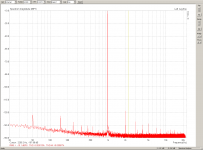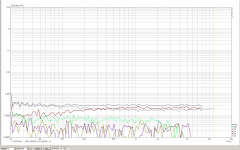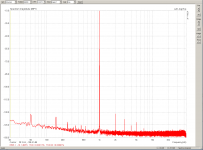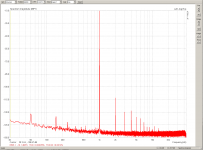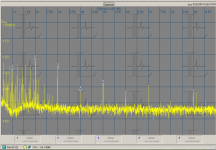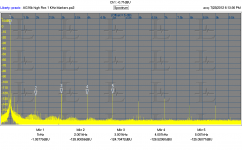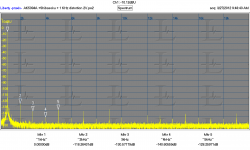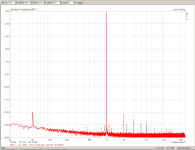Lemon, I suppose this is with unbalanced input. With balanced input, the measurements are bound to be better. Looking at the schematic, it is not difficult to see why this should be so. U15b performs a re-balancing act on unbalanced signals. In case of a true balanced signal with both signal lines swinging equally in opposite directions, U15 only functions as a DC reference.
In case of a unbalanced signal, U15B provides positive feedback to U9 so that the cold signal line becomes active and inverted. This ensures that whatever the input, balanced, unbalanced or balanced with one cold signal line, the ADC always get a balanced signal.
It works very well, but it comes at a penalty - most notably a rise in distortion with increasing frequency.
- Yes, you have right. I used the ubalanced input at the loopback test. It is my usually test input due to the 1M resistance that it has.
...To make the EMU 0404 a better tool for unbalanced inputs, taking out U9 and U15b might work. It then has to be replaced by the kind of setup used in the 0404 to make a balanced output out of an unbalanced one, just a straight out inverting opamp. I haven't tried it and I doubt I will because of the time involved to do so.
- It is very interesting information and thanks for that. Maybe I'll try the next time that mod my card as I use it only for measuring purposes.
I am also playing with possible use of an external build of the AKM4490.
So far I got this spectra (below).
I would confirm the concern of Arnyk what regards Arta and more independent soundcards. Also I had to use an external driver for the Xmos based Dac.
Which is a pity for Steps, especially.
I noted that for close to max output levels (up to ~-2dB) this AKM dac still measures at around 0.0002 % THD, which is way better than the EMU's own 4398. But at 'sweet spot' both dacs perform almost the same --- uhm, with the 'slight' drawback that the AKM dac applies a balanced-SE conversion (OPA1612) and this SE output is tested here, entering the soundcard unbalanced.
So with proper full balanced signal path... I don't dare to immagine what would happen..
A note about jitter: this dac shows the smallest side skirts that I have seen up to now. It's considerably better than the EMU cards internal dac jitter. Still including the same jittery clock for the ADC.
A note to Arnyk: a very nice result with the chinese dac. Maybe the only visible drawback is the jitter, in your spectra.
George
So far I got this spectra (below).
I would confirm the concern of Arnyk what regards Arta and more independent soundcards. Also I had to use an external driver for the Xmos based Dac.
Which is a pity for Steps, especially.
I noted that for close to max output levels (up to ~-2dB) this AKM dac still measures at around 0.0002 % THD, which is way better than the EMU's own 4398. But at 'sweet spot' both dacs perform almost the same --- uhm, with the 'slight' drawback that the AKM dac applies a balanced-SE conversion (OPA1612) and this SE output is tested here, entering the soundcard unbalanced.
So with proper full balanced signal path... I don't dare to immagine what would happen..
A note about jitter: this dac shows the smallest side skirts that I have seen up to now. It's considerably better than the EMU cards internal dac jitter. Still including the same jittery clock for the ADC.
A note to Arnyk: a very nice result with the chinese dac. Maybe the only visible drawback is the jitter, in your spectra.
George
Attachments
I know that ARTA's author is a member here and has a thread on ARTA. Don't remebmer his handle but may be worth to look it up and make him aware of this.
Edit: user name iMAT, see thread named - what is in a name - ARTA 🙂
Real name Ivo Marteljan
Jan
Edit: user name iMAT, see thread named - what is in a name - ARTA 🙂
Real name Ivo Marteljan
Jan
Last edited:
Right up front I can tell you that software like Arta that seems to be based on the odd idea that the DAC and the ADC are always in the same audio interface is not happy with this approach.
Interesting that Arta is limited this way, but the Audio Rightmark program is not.
While I had a similar experience, i still had a lurking feeling that maybe it is not exactly true.
It did seem like in the past I did not have this problem, being forced by Arta to use the same device both for output and input. So went back to control.
This problem only shows up with Asio drivers. Using windows drivers there is free choice.
It could be about mixing the two layers? Maybe an Asio driver for xmos, in my case could be a solution?
In the tests with the AKM4490 dac I wished to use Asio for the Emu1616 card because it returns 3 times higher distortion with wdm drivers! More precisely at low sample rates it's ~OK, but at 88- 96k already there is a big difference between the two modes.
Jan, thanks for the note put in the other thread! I continued here, could not decide..
George
That's an interesting approach. I wonder if there are more here who tried this concept, i.e. using two different units each with strength in their separate role?
Well (speaking for MS Windows), if the driver & used interface (WASAPI Exclusive, ASIO) with underlying HW supports this.
Speaking USBStreamer using ASIO is not multi host (HW) able, in the other hand WASAPI would work.
Remark: WDM & WASAPI none Exclusive mode should be skipped do the not bit accurate sample rate conversion 😱 but may OK for speaker tests.
Cheers
Hp
Hp, that is an interesting product on your site. Is there a price information?
Jan Didden
Order
$300.
Joseph K- What PC hardware and OS are you using? I have not seen the higher distortion floor with WDM drivers at 192 KHz (or 174 KHz). However if any point in the chain decides to resample your efforts will be destroyed.
Another issue is having a clean enough system to not get measurements interrupted by some stray process.
Another issue is having a clean enough system to not get measurements interrupted by some stray process.
Dear Demian,
I think you are right, one should be careful with these 'pronouncements'. I have used arta with the emu card without any serious problems with the wdm drivers. I did notice a slight improvement in the noise & distortion values when using asio, but not this size, not 3* decrease. It only happened in this mixed setup, that i noticed this very surprising big difference between drivers/ settings. It could be the xmos win drivers? And definitely the distortion increased when passing from 48k to 88.2k, so it really does have something to do with the system rate conversions.
I will repeat and document better, this was only a sidenote while looking for something else.
The dac is the diyinhk unit, driven by a jlsounds i2s board with external Crystek oscillators.
The laptop is an old Lenovo, this one:
Lenovo ThinkPad Z61p 0674 Specs - CNET
With xp on it, original drivers, not particularly optimized, though stupid extra processes decimated a bit, and real time priority given to the software and emu drivers.
I normally do not have dropouts and not frequent blue death events. And spectra results are consistent even over long time periods. Though when looking for jitter, long averaging , there i do suffer of dropouts - would be happy to learn of better optimization!
George
I think you are right, one should be careful with these 'pronouncements'. I have used arta with the emu card without any serious problems with the wdm drivers. I did notice a slight improvement in the noise & distortion values when using asio, but not this size, not 3* decrease. It only happened in this mixed setup, that i noticed this very surprising big difference between drivers/ settings. It could be the xmos win drivers? And definitely the distortion increased when passing from 48k to 88.2k, so it really does have something to do with the system rate conversions.
I will repeat and document better, this was only a sidenote while looking for something else.
The dac is the diyinhk unit, driven by a jlsounds i2s board with external Crystek oscillators.
The laptop is an old Lenovo, this one:
Lenovo ThinkPad Z61p 0674 Specs - CNET
With xp on it, original drivers, not particularly optimized, though stupid extra processes decimated a bit, and real time priority given to the software and emu drivers.
I normally do not have dropouts and not frequent blue death events. And spectra results are consistent even over long time periods. Though when looking for jitter, long averaging , there i do suffer of dropouts - would be happy to learn of better optimization!
George
AKM4490 at higher sample rates?
Thanks to Demian, this had to be cleared up. I have done some more test what regards asio or wdm drivers, Arta, loopback and distortion levels.
First of all, I have seen a distortion level rise with sampling rate when testing the XMOS jlsounds+AKM4490 combo into the AK5394A adc of the EMU1616 card. In general it's to be expected, but I feel it's a bit too high, more than what I used to observe with the 4398 in the EMU.
I was wrong ascribing that to the system drivers, it's the hardware itself.
The used drivers do not change that. Arta do not enter here, in fact it works wonderfully as always. When Asio is used, Arta does not permit to use different in/out units but using windows drivers it's possible. Using wdm drivers it's better to be aware of the system internal conversions, in fact 48K multiples work best. But that's enough, the results will not be strongly distorted.
Using Asio drivers the spectrum cleans up a tiny bit better, so I prepared a series of tests using ARTA reading the EMU ADC with ASIO drivers, and the 4490 Dac was driven externally at different sampling rates but always the same generator level, -10dBFs, (~600mV RMS out). The results are in the file
AKM4490-EMUasio.pdf
For comparison, I used ARTA in the conventional way, wdm drivers, AKM4490 looped back to ADC input at always the same level -10dbFs at different sample rates. Also this file is attached, AKM4490+EMU1616_wdm.pdf
Also have tried driving the 4490 with an Amanero, same results but worse noise floor. Seems to be inherent the dac board. or the dac itself? Definitely not the analog output drivers, they always see 1kHz carrier.
tried to look up other people's result, but also JensH was showing up to now only the 48K sampling rate.
ArnyK, may I ask you how did you obtain your nice spectra? 96KHz ADC sampling, but the dac was driven at..?
A bit puzzled.. George Edit: flipping thorugh the PDF gives nice prompt comparison
Thanks to Demian, this had to be cleared up. I have done some more test what regards asio or wdm drivers, Arta, loopback and distortion levels.
First of all, I have seen a distortion level rise with sampling rate when testing the XMOS jlsounds+AKM4490 combo into the AK5394A adc of the EMU1616 card. In general it's to be expected, but I feel it's a bit too high, more than what I used to observe with the 4398 in the EMU.
I was wrong ascribing that to the system drivers, it's the hardware itself.
The used drivers do not change that. Arta do not enter here, in fact it works wonderfully as always. When Asio is used, Arta does not permit to use different in/out units but using windows drivers it's possible. Using wdm drivers it's better to be aware of the system internal conversions, in fact 48K multiples work best. But that's enough, the results will not be strongly distorted.
Using Asio drivers the spectrum cleans up a tiny bit better, so I prepared a series of tests using ARTA reading the EMU ADC with ASIO drivers, and the 4490 Dac was driven externally at different sampling rates but always the same generator level, -10dBFs, (~600mV RMS out). The results are in the file
AKM4490-EMUasio.pdf
For comparison, I used ARTA in the conventional way, wdm drivers, AKM4490 looped back to ADC input at always the same level -10dbFs at different sample rates. Also this file is attached, AKM4490+EMU1616_wdm.pdf
Also have tried driving the 4490 with an Amanero, same results but worse noise floor. Seems to be inherent the dac board. or the dac itself? Definitely not the analog output drivers, they always see 1kHz carrier.
tried to look up other people's result, but also JensH was showing up to now only the 48K sampling rate.
ArnyK, may I ask you how did you obtain your nice spectra? 96KHz ADC sampling, but the dac was driven at..?
A bit puzzled.. George Edit: flipping thorugh the PDF gives nice prompt comparison
Attachments
Last edited:
Attached is a measurement of an AK4490 made using the JK generator (a fantastic tool) and measured through a Shibasoku 725 distortion analyzer to lower the reference floor a lot. This is the residual of the chip in the demo board fed via I2S at 352.8 KHz. In my testing I have not seen a substantial difference at lower sample rates.
Attachments
These are some measurements I made some time ago of the AKD5394A demo board with a few tweaks. 4V is essentially 0 dB and 2V is -6 dB. The AK5394A distortion drops a lot below 0 dB as well.
The third plot is the fully tweaked demo board (improved clock + opamps + power supply tweakes + best clock chain settings + random luck.
I don't seem to have a composite of the two (5394A + 4490) at this point.
its clear that much better performance can be had from a stock 1616m or 1212m if you can figure out how to get it. The ADC is the lowest distortion available still.
The third plot is the fully tweaked demo board (improved clock + opamps + power supply tweakes + best clock chain settings + random luck.
I don't seem to have a composite of the two (5394A + 4490) at this point.
its clear that much better performance can be had from a stock 1616m or 1212m if you can figure out how to get it. The ADC is the lowest distortion available still.
Attachments
Dear Demian,
The last plot.. cruel numbers 😎
Also the noise floor is ~8-10dB less than what best I have seen from the 1616m card.
Sigh.. will have to open it again -- always that lurking feeling of last operation.. (with the patient dead)
Only point: I think my 1616m card do work in full strength, without problem. The above observed distortions all come from the external dac. Notwithstanding, your numbers are a strong invitation for further fiddling..
And clearly I have a problem with my 4490 install.
Ciao, George
The last plot.. cruel numbers 😎
Also the noise floor is ~8-10dB less than what best I have seen from the 1616m card.
Sigh.. will have to open it again -- always that lurking feeling of last operation.. (with the patient dead)
Only point: I think my 1616m card do work in full strength, without problem. The above observed distortions all come from the external dac. Notwithstanding, your numbers are a strong invitation for further fiddling..
And clearly I have a problem with my 4490 install.
Ciao, George
Last edited:
Demian, you write "its clear that much better performance can be had (THAN?) from a stock 1616m or 1212m if you can figure out how to get it.", but I put in a "THAN"between brackets, because that is what you want to say?
Joseph, that is hard to say without knowing how many bins in the FFT.
Joseph, that is hard to say without knowing how many bins in the FFT.
Last edited:
ArnyK, may I ask you how did you obtain your nice spectra? 96KHz ADC sampling, but the DAC was driven at..?
The DAC was driven at 96 KHz. 96 KHz into the DAC, 96 KHz out of the AP 24192.
Arnyk, thanks! You again confirmed that i have something wrong.
Vacuphile, i think his figures show it wanted to be with a 'THAN'..
Vacuphile, i think his figures show it wanted to be with a 'THAN'..
I think it was a 4 million point fft so the noise won't relate easily. I may also have had enough drift in the oscillator to move the harmonics off a bin so don't put a lot of stock in the measurement. I'm rebuilding my shop after moving which has really taken a lot longer than planned. Once it's up again I see if I can duplicate the measurements. The 16M point FFT takes 20 minutes but is useful for finding little birdies in the noise.Dear Demian,
The last plot.. cruel numbers 😎
Also the noise floor is ~8-10dB less than what best I have seen from the 1616m card.
Sigh.. will have to open it again -- always that lurking feeling of last operation.. (with the patient dead)
Only point: I think my 1616m card do work in full strength, without problem. The above observed distortions all come from the external dac. Notwithstanding, your numbers are a strong invitation for further fiddling..
And clearly I have a problem with my 4490 install.
Ciao, George
Sent from my SGH-M919 using Tapatalk
Ok, i have found the bug in my diyinhk AK4490 board configuration. It is coming with manual sampling rate configurafion, this should set to auto, or taking care externally, while changing sample rates.
Now it does the right thing: the first shot is the usual configuraton, AK4490 board at 44,1kHz sample rate, EMU1616m input at 48kHZ sample rate, asio drivers.
The second shot is the same setup except the AK4490 board driven at 192kHz. The only change I see is in the jitter. (Sensitivity to jitter)
Now it does the right thing: the first shot is the usual configuraton, AK4490 board at 44,1kHz sample rate, EMU1616m input at 48kHZ sample rate, asio drivers.
The second shot is the same setup except the AK4490 board driven at 192kHz. The only change I see is in the jitter. (Sensitivity to jitter)
Attachments
Hi Joseph,
still not at the beach and having nice cold beers 😀
>> The second shot is the same setup except the AK4490 board driven at 192kHz. The only change I see is in the jitter. (Sensitivity to jitter)
yes, if Arta allows .... or what I support:
- Center linear scale to 1khz or use a fs/4 signal for jitter measurement
- use none FFT Window type if possible but a better performing (high order) FFT Window
- then zoom in, whether the jitter is hum or else related
Hp
still not at the beach and having nice cold beers 😀
>> The second shot is the same setup except the AK4490 board driven at 192kHz. The only change I see is in the jitter. (Sensitivity to jitter)
yes, if Arta allows .... or what I support:
- Center linear scale to 1khz or use a fs/4 signal for jitter measurement
- use none FFT Window type if possible but a better performing (high order) FFT Window
- then zoom in, whether the jitter is hum or else related
Hp
- Status
- Not open for further replies.
- Home
- Design & Build
- Equipment & Tools
- USB vs PCIe Sound Card for audio analysis
